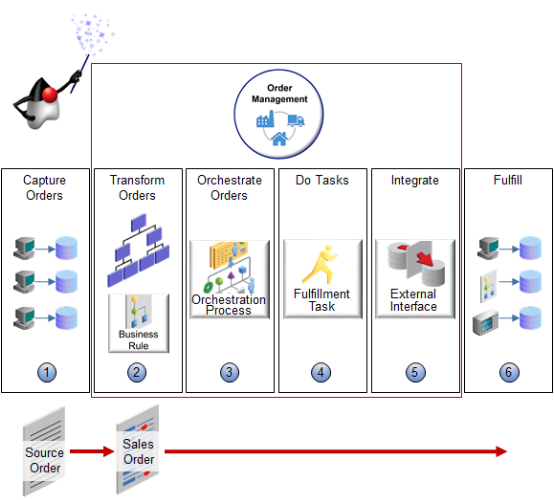How Data Flows Through Order Management
Order Management uses processes and tasks to fulfill each source order that it receives from a source system.

Note
-
Capture orders. A source system that resides outside of Order Management sends a source order to Order Management.
The terminals and databases in step 1 in the diagram represent different channels that your deployment can use as source systems. For example, a legacy system, or some other channel.
The flow for a sales order that the Order Entry Specialist creates in the Order Management work area is similar, except it typically starts with orchestration at step 3.
-
Transform orders. Transformation rules separate the source order into a hierarchy that Order Management can use and process.
Transformation finishes, then assignment rules assign an orchestration process to the sales order.
-
Orchestrate orders. One or more orchestration processes contain steps that do fulfillment tasks. Each fulfillment request starts here.
-
Do tasks. Task services send a request to the fulfillment system to run the fulfillment task, such as ship the item or invoice the item. A system that resides outside of Order Management can also send a request to a task service.
-
Integrate. Here's what the interface does.
-
Cross-references data that the request contains.
-
Uses routing rules to identify the fulfillment system that fulfills each fulfillment line. For details, see Route Requests from Order Management to Fulfillment Systems Without Cross-References.
-
A connector sends the request to the fulfillment system.
-
-
Fulfill. The fulfillment system processes the request.
-
The fulfillment system accepts the request then sends a reply.
-
The interface converts the reply from the fulfillment system.
-
The task service processes the reply from the fulfillment system.
-
The orchestration process runs the next orchestration process step.
-
Interface
The interface manages communication between Order Management and your fulfillment system.
-
The fulfillment system doesn't communicate directly with the orchestration process. Instead, the interface provides an intermediary that Order Management uses to route requests.
-
Order Management uses a web service to route each request from the task service to the fulfillment system, and then from the fulfillment system to the task service.
-
The connector modifies the structure and content of the outbound message so it matches the inbound interface that the fulfillment system uses.
-
You can set up each web service and routing rule, then register the connector web service. This set up integrates the fulfillment system with the interface.
The interface provides benefits.
-
Keeps the source system or fulfillment system that resides outside of Order Management separate from the orchestration process so it isn't necessary to modify the orchestration process every time you integrate another source system or fulfillment system.
-
Provides a flexible integration that you can use in a Service Oriented Architecture (SOA) with a system or application that resides outside of Order Management.
-
Provides a complete, open, and integrated solution that lowers cost of ownership.